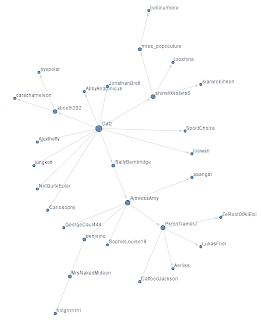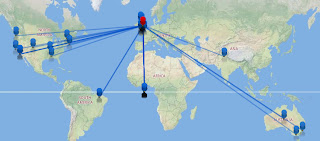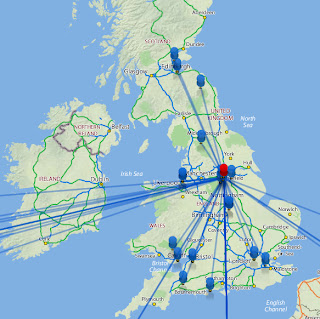More Twitter Insights
01 Oct 2010 IntroductionsFirst of all, following a few recent new follows, here's the revised introductions graph.
[Click to enlarge. Interactive version here.]
Main new thing going on is that some of the chains are getting longer. Also I put in some of the people I missed out last time (for clarity), just so it's more complete.
Gender
Recently, I thought I noticed that a lot of my timeline was filled with tweets by women-folk. Obvious first conclusion being that I must now be following more woman than men.
Having looked into this matter further, I actually found that I'm following almost equal numbers of men (15) and women (14) - excluding celebrities and dead-accounts.
Next question then is - What the hell?
Okay, this next theory may sound a little sexist but bear with me - what if it's just that the stereotypes are true and women really do talk more (on average)?
Given that a recent update to the Twitter API borked my previously mentioned programs and I don't (yet) know how to fix them, I had to get numbers and such by hand. Which made life a little harder.
Individual tweet rates are only approximate, and based on an average over the last ~14days. And I'll be honest, I don't entirely trust the source numbers. Also, I couldn't get numbers for some people, which isn't ideal.
NB/ For more applicable results, it would've made sense to only count tweets that would have shown up in my timeline - i.e. excluding tweets @ people I don't follow. But working that out would require a lot more effort, and frankly I don't care enough about that degree of correctness to bother.
Anyway, here are the results:
Men:
Average = 5.2 tweets/day
Standard Deviation = 4.29
Women:
Average = 6.6 tweets/day
Standard Deviation = 4.81
So yeah. The women tweet about 27% more than men. They also have a slightly greater spread of rates.
Basically, the women that tweet the most, tweet more than the men who tweet the most. Which pushes the average and spread up.
Again, these results are only approximate and only apply to my personal network, and could vary (significantly) over time. Also if we had the missing data, it could turn out the opposite is actually true.
In fact, someone already did research on this matter for a random sample of 300,000 Twitter users. What they found was that, while there are slightly more women (55%) on twitter than men,
We found that an average man is almost twice more likely to follow another man than a woman. Similarly, an average woman is 25% more likely to follow a man than a woman.And that, on average, men and women tweet at about the same rate.
Maybe I'm just following particularly talkative women/quiet men...
Location
Just because I can.
These are maps of people who follow me, rather than just people I follow (which I would've prefered). But I couldn't find something that could do that, so gave up and settled on this. Interactive version and make your own here.
World View
UK View
[Click to enlarge.]
Bios
For the people in the graph at the top of the page, I took their bios and made this word cloud [click to enlarge. Interactive here.]:
This is the company I keep - geeks and writers.
And One More Thing
Previously mentioned Malcolm Gladwell wrote an article for The New Yorker recently, about activism in social networks - Twitter in particular - called "Why the Revolution Will Not Be Tweeted".
In it, he explains how and why social-media based 'activism', is quite different from and less effective than real-world activism - the sort of activism that brings about genuine change. Rather, social-media activism is good at getting lots of people to participate, but they (mostly) only do so with the least amount of effort.
So, for example, they might join a FB group, sign an online petition, or even do the sort of crap 4chan pulls. But they tend not to actually go out and protest, where genuine commitment is needed and where there's the risk of say physical harm. And the resulting pay-off is much less significant as a result.
"This is because, Gladwell says, online networks are all about weak ties — a weak tie is a friend of a friend, or a casual acquaintance — whereas real activism depends on strong ties, or those people you know and trust"
In response, Jonah Leher - writing for Wired - argues that Gladwell's dismissal of weak ties in social activism may be a little short sighted. And in particular it can be necessary for a leader of a cause to have lots of weak ties, so as to have greater reach - or at least, this seems to be the case in real world situations.
Gladwell also talks about how a hierarchically structured group is more effective in activism than a decentralized-network structured group - as is often the form online groups take. And again, this is required for greater levels of discipline, control and commitment.
Both make good arguments, and both articles are worth reading.
Oatzy.



